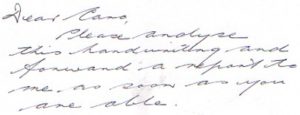Samples
The following examples of handwriting analysis introduce elements which a graphologist must correlate and synthesise, to determine personality. It should be noted that a detailed profile demands correlation of up to two-hundred indicies.
Sample A – Young Children

Because much can be told from pictorial value, even the earliest strokes on paper give us clues about our children. Preschoolers display great variations in the style and development of their scribbles, drawings and first attempts at letters. Invariably they find a preferred pattern and repeat it constantly; so the broad principles of analysis can be applied.
This example is taken from three four year olds in the same preschool group. Ryan is starting to write, drawing his letters as separate pictures, while Matthew reveals good development for his age; he has learn that letters follow one another. Sophie writes her surname (not shown for privacy reasons), which according to her mother, she was never taught but just ‘picked up’. It is very unusual for children in this age group to attempt their surname, let alone master it. Her letters are well formed, legible and follow one another in line. She appreciates that words need to be separated, and her writing reveals a remarkable maturity and sophistication for a four year old.
Sample B – Teenager

The irregularity of size, slope, and spacing makes the example difficult to read. The fluctuating slope indicates emotional confusion, and daggers and hooks (especially on t bars) indicate anger. By contrast, clever connections, speedy writing, and a tendency towards the use of thread all suggest a marked intelligence. The writer is clearly underachieving and needs help, to reach their full potential.
Sample C – Adult

This writing reveals good organisation, clarity of thought and a willingness to comply, evident in the consistent margins, spacing and slope. Elaborated capitals indicate pride. The writer is outgoing. Hooked lead-ins tell us that the past is important to the writer. The wide letter spacing indicates generosity. The lower stick formations, with firm pressure, indicate a writer who will get the job done.